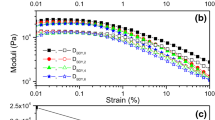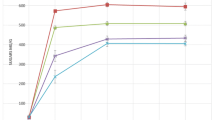Abstract
The swelling properties and thus baking performance of starch strongly depend on mechanical starch modification (MSM), which can be influenced by grinding. To analyze the effect of starch influencing factors on dough fermentation properties and specific bread volume, different MSM levels were obtained using a ball mill. This treatment led to an increase in the water-holding capacity and a decrease in the β-amylase activity of the flour. Baking tests were conducted with varied starch modification levels and water additions to analyze the effect of mechanical flour modification and the resulting changes in hydration and gas formation properties of the dough on bread quality. The specific bread volume was lower with high-MSM flour than with low-MSM flour, regardless of the adapted water addition. Therefore, the effect of MSM on dough fermentation properties was examined with respect to different water additions. Despite increasing the water addition, the time of porosity (Tx) of high-MSM dough was significantly lower than that of low-MSM dough. However, the amount of gas leakage after 60 min was quite low for high-MSM dough (gas retention coefficient ~99.5 %) and thus not considered significant. By adding 58 and 83 g water 100 g−1 flour, the gas retention coefficient after 60 min was 100 %. The results also show that lower enzymatic activity with high MSM has no significant effect on the produced gas volume during fermentation. However, increasing MSM leads to a reduced dough height (Hm).







Similar content being viewed by others
References
Chiu C-W, Solarek D (2009) Modification of starches. Starch Chem Technol 3:629–655
Yu J, Wang S, Wang J, Li C, Xin Q, Huang W, Zhang Y, He Z, Wang S (2015) Effect of laboratory milling on properties of starches isolated from different flour millstreams of hard and soft wheat. Food Chem 172:504–514. doi:10.1016/j.foodchem.2014.09.070
Nowakowski D, Sosulski FW, Hoover R (1986) The effect of pin and attrition milling on starch damage in hard wheat flours. Starch Stärke 38(8):253–258. doi:10.1002/star.19860380802
Tran TT, Shelat KJ, Tang D, Li E, Gilbert RG, Hasjim J (2011) Milling of rice grains. The degradation on three structural levels of starch in rice flour can be independently controlled during grinding. J Agric Food Chem 59(8):3964–3973
Banafa W (2004) Einfluss der Prallvermahlung und Windsichtung auf die stoffliche Zusammensetzung und Verarbeitungseigenschaften von Weizenmehlen. Technische Universität Berlin, Berlin
Barrera G, Pérez G, Ribotta P, León A (2007) Influence of damaged starch on cookie and bread-making quality. Eur Food Res Technol 225(1):1–7. doi:10.1007/s00217-006-0374-1
Dhital S, Shrestha AK, Flanagan BM, Hasjim J, Gidley MJ (2011) Cryo-milling of starch granules leads to differential effects on molecular size and conformation. Carbohydr Polym 84(3):1133–1140. doi:10.1016/j.carbpol.2011.01.002
Hasjim J, Li E, Dhital S (2013) Milling of rice grains: effects of starch/flour structures on gelatinization and pasting properties. Carbohydr Polym 92(1):682–690. doi:10.1016/j.carbpol.2012.09.023
Charm S, Wong B (1970) Enzyme inactivation with shearing. Biotechnol Bioeng 12(6):1103–1109
Abebe W, Collar C, Ronda F (2015) Impact of variety type and particle size distribution on starch enzymatic hydrolysis and functional properties of tef flours. Carbohydr Polym 115:260–268. doi:10.1016/j.carbpol.2014.08.080
Berton B, Scher J, Villieras F, Hardy J (2002) Measurement of hydration capacity of wheat flour: influence of composition and physical characteristics. Powder Technol 128(2–3):326–331. doi:10.1016/S0032-5910(02)00168-7
Barrera GN, Bustos MC, Iturriaga L, Flores SK, León AE, Ribotta PD (2013) Effect of damaged starch on the rheological properties of wheat starch suspensions. J Food Eng 116(1):233–239. doi:10.1016/j.jfoodeng.2012.11.020
Li E, Dhital S, Hasjim J (2014) Effects of grain milling on starch structures and flour/starch properties. Starch Stärke 66(1–2):15–27. doi:10.1002/star.201200224
Tester RF, Morrison WR (1990) Swelling and gelatinization of cereal starches. I. Effects of amylopectin, amylose, and lipids. Cereal Chem 67(6):551–557
Jekle M, Becker T (2011) Dough microstructure: novel analysis by quantification using confocal laser scanning microscopy. Food Res Int 44(4):984–991. doi:10.1016/j.foodres.2011.02.036
Dhital S, Shrestha AK, Gidley MJ (2010) Effect of cryo-milling on starches: functionality and digestibility. Food Hydrocoll 24(2–3):152–163. doi:10.1016/j.foodhyd.2009.08.013
McCleary BV, Sheehan H (1987) Measurement of cereal α-amylase: a new assay procedure. J Cereal Sci 6(3):237–251. doi:10.1016/S0733-5210(87)80061-9
van der Veen ME, Van Iersel DG, van der Goot AJ, Boom RM (2004) Shear-induced inactivation of α-amylase in a plain shear field. Biotechnol Prog 20(4):1140–1145. doi:10.1021/bp049976w
Ganesh K, Joshi JB, Sawant SB (2000) Cellulase deactivation in a stirred reactor. Biochem Eng J 4(2):137–141. doi:10.1016/S1369-703X(99)00045-5
Gunjikar TP, Sawant SB, Joshi JB (2001) Shear deactivation of cellulase, exoglucanase, endoglucanase, and β-glucosidase in a mechanically agitated reactor. Biotechnol Prog 17(6):1166–1168
Kaya F, Heitmann JA, Joyce T (1996) Deactivation of cellulase and hemicellulase in high shear fields. Cellul Chem Tech 30 (1–2):49–56
Torley PJ, van der Molen F (2005) Gelatinization of starch in mixed sugar systems. LWT Food Sci Technol 38(7):762–771. doi:10.1016/j.lwt.2004.09.001
Spies RD, Hoseney RC (1982) Effect of sugars on starch gelatinization. Cereal Chem 59(2):128–131
Acknowledgments
The research project was supported by the German Ministry of Economics and Technology (via AIF) and the FEI (Forschungskreis der Ernährungsindustrie e.V., Bonn). Project AIF 17718 N.
Author information
Authors and Affiliations
Corresponding author
Ethics declarations
Conflict of interest
None.
Compliance with ethics requirements
This article does not contain any studies with human or animal subjects.
Rights and permissions
About this article
Cite this article
Hackenberg, S., Verheyen, C., Jekle, M. et al. Effect of mechanically modified wheat flour on dough fermentation properties and bread quality. Eur Food Res Technol 243, 287–296 (2017). https://doi.org/10.1007/s00217-016-2743-8
Received:
Revised:
Accepted:
Published:
Issue Date:
DOI: https://doi.org/10.1007/s00217-016-2743-8




